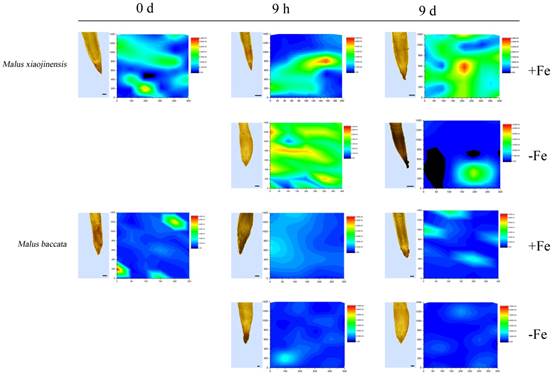| Reactive Oxygen Species Function to Mediate the Fe Deficiency Response in an Fe-efficient Apple Genotype:An Early Response Mechanism for Enhancing Reactive Oxygen Production |
| From: PublishDate:2017-06-16 Hits: |
Reactive oxygen species (ROS) are important signaling molecules in plants that contribute to stress acclimation. Their study demonstrated that ROS play a critical role in Fe deficiency-induced signaling at an early stage in Malus xiaojinensis. Once ROS production has been initiated, prolonged Fe starvation leads to activation of ROS scavenging mechanisms. Further, they demonstrated that ROS scavengers are involved in maintaining the cellular redox homeostasis during prolonged Fe deficiency treatment. Taken together, their results described a feedback repression loop for ROS to preserve redox homeostasis and maintain a continuous Fe deficiency response in the Fe-efficient woody plant M. xiaojinensis. More broadly, their study reveals a new mechanism in which ROS mediate both positive and negative regulation of plant responses to Fe deficiency stress. A team from Institute for Horticultural Plants, College of Horticulture, China Agricultural University has researched ROS mediate the Fe uptake mechanism. Their research has been published on November 16th, 2016 in Frontier in Plant Science. The team found that Fe content were different between M. xiaojinensis, an Fe-eficiency woody plant and M. baccata, an Fe-deficiency woody plant under Fe deficiency stress. By using the X-ray fluorescence (XRF) maps of the Fe distribution pattern in the roots, they showed the Fe content in M. xiaojinensis roots was decades higher than that in M. baccata roots They speculated that the relative high active iron contents caused by the immanently active root ferrous uptake and increased root ferrous uptake in response to Fe deficiency stress which were the dominant mechanisms for the tolerance to iron deficiency. The mechanism of root ferrous uptake was activated in the early stage of Fe-deficiency by ROS production.
Fe distributions in roots of M. xiaojinens and M. baccata with Fe-sufficient (+Fe) and Fe-deficient (-Fe) treatment. Longitudinal sections of root top section samples observed by microscope (left; bars = 100 μm) and synchrotron radiation X-ray fluorescence(SR-mXRF) scanning images of the respective samples (right). The samples were treated with +Fe (40 mMFeNa-EDTA), or –Fe (0 Mm FeNa-EDTA) for 0 days, 9 hours, and 9 days. The color of the bars from blue to red indicates the Fe content from low to high. This research provides the scientific clues to observe Fe distribution and content in plant roots, visually. “However, although we had observed Fe content in apple rootstocks, the location of ferrous have not been seperated from ferric iron in plants, we need the improved synchrotron radiation X-ray fluorescence to solved this problem” explains Zhenhai Han, the president of the horticulture college and the profession of Institute for Horticultural Plants. Article: Chaohua Sun, Ting Wu, Longmei Zhai, Duyue Li, Xinzhong Zhang, Xuefeng Xu, Huiqin Ma,Yi Wang*, Zhenhai Han*. Reactive Oxygen Species Function to Mediate the Fe Deficiency Response in an Fe-efficient Apple Genotype:An Early Response Mechanism for Enhancing Reactive Oxygen Production. Frontier in Plant Science,7:1726. doi: 10.3389/fpls.2016.01726 |
|
|
| Chinese
- Metal-free efficient photocatalyst for stable visible water splitting——Top ten major scientific progresses in China in 2015
- The nano-resolution imaging platform was awarded the first rate prize of Beijing Science and Technology in 2014
- Beamline 1W1 of BSRF started to runoperate in the couplingparasitic mode of BEPCII
- Synthesis of High Performance Polymer Materials for Field Effect-Transistors
- Surfactant molecular aggregates in green solvents
- GIXRD has played an important role in the characterization of organic thin-film transistors
Copyright © 2011 - 2012 Beijing Synchrotron Radiation Facility


